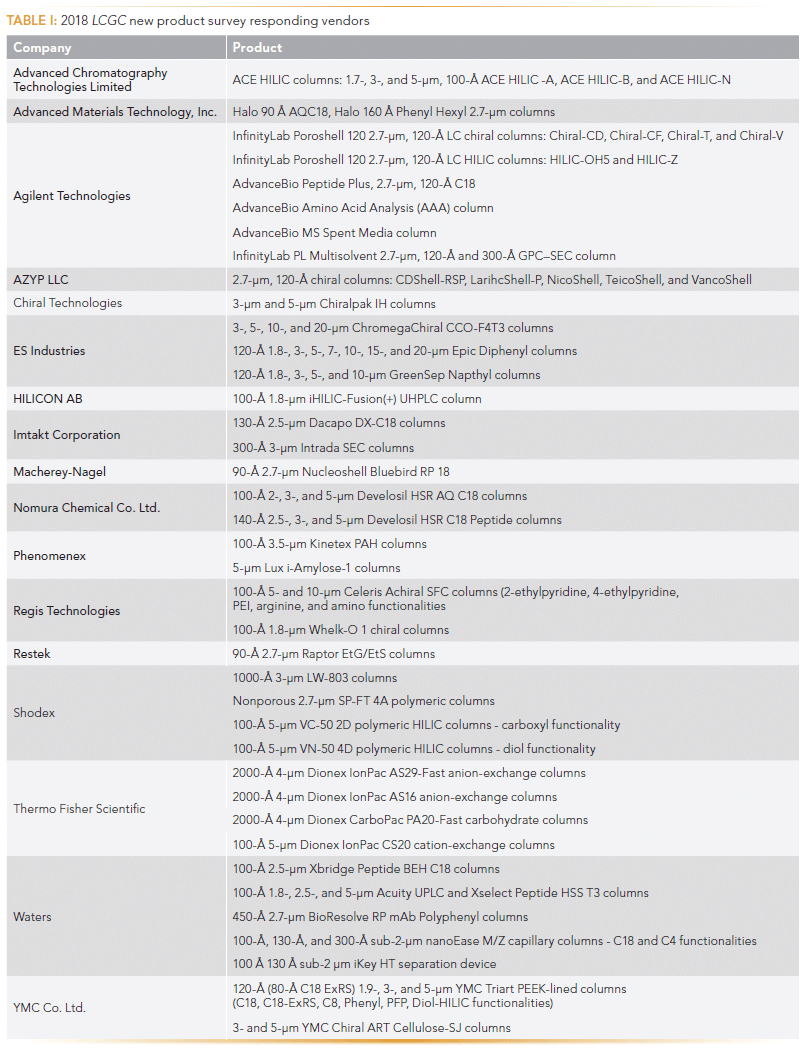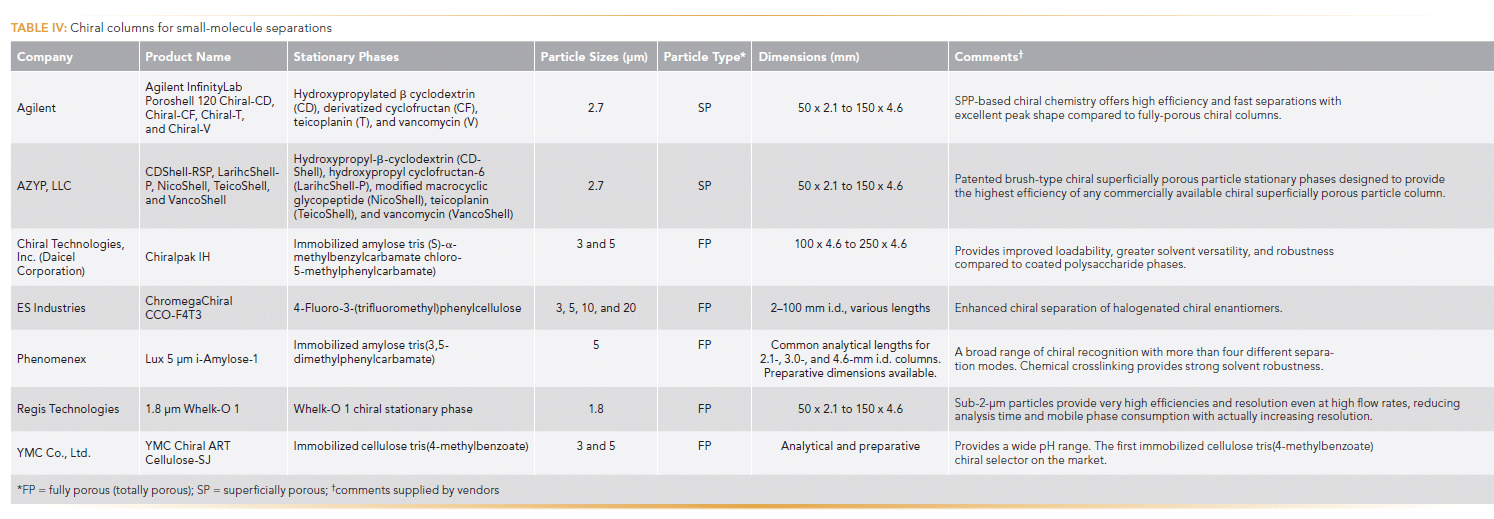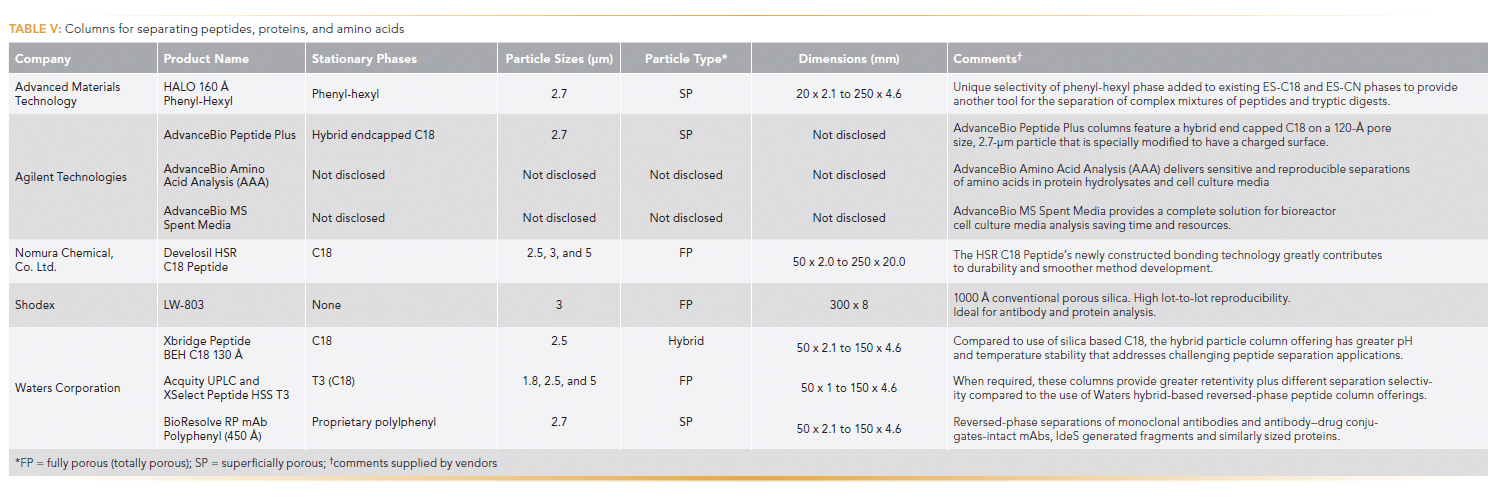New Chromatography Columns and Accessories for 2018
LCGC North America
Our annual review of new liquid chromatography columns and accessories, including columns for reversed-phase, HILIC, chiral, SEC, GPC, ion-exchange, and SFC separations of small and large molecules.
This installment of "Column Watch" is intended to cover chromatography columns and accessories commercially released after Pittcon 2017 through this year's conference held in Orlando, Florida. LCGC once again sent out a survey in early 2018 asking vendors to supply them with any products launched after Pittcon 2017. Other areas such as gas chromatography (GC), instrumentation, and sample preparation are covered elsewhere. Because information for this article is obtained sporadically over the course of many months, it is very possible that some information has been missed. The reader is encouraged to check with specific vendor sites for additional products as well as more detailed information regarding what is covered here.
The vendors that responded to the survey with high performance liquid chromatography (HPLC) and ultrahigh-pressure liquid chromatography (UHPLC) columns are listed in Table I. The product range is highly varied from traditional reversed-phase columns using fully porous materials to columns designed for alternate separation technologies such as supercritical fluid chromatography (SFC). The present discussion is organized around several classes of liquid chromatography (LC) columns. Small-molecule reversed-phase columns, hydrophilic-interaction chromatography (HILIC) columns, and chiral columns continue to surface and are thus discussed separately. Columns intended for reversed-phase analysis of large molecules including proteins, peptides, and amino acids make up another separate category. Alternative modes of chromatography for both small and large molecules such as ion-exchange, size-exclusion or gel permeation, and supercritical fluid chromatography are also discussed individually. Finally, new developments in nano- and microseparations are presented. Trends noted throughout the article are based on comparisons to 2016 (1) and 2017 (2) reports.

Small-Molecule Reversed Phase
The product offerings assigned to the small-molecule reversed-phase category are listed in Table II. A total of 18 new column options, including existing particle and chemistry combinations packed in alternative hardware designs are shown. Continuing with recent trends, many of the new columns are intended to round out selectivity or particle size offerings within existing lines. Of the 18 columns listed, nine are manufactured using superficially porous particles (SPPs), indicating that the particle architecture continues to garner attention. Agilent Technologies expanded its InfinityLab Poroshell 120 line by applying existing surface chemistries to a 1.9-µm (SPP) particle size. Two specialty columns based on SPP technology are also noted. Phenomenex reported the release of the Kinetex 3.5 PAH column, which uses a polymerically bonded C18 on the company's SPP platform for highly efficient separation of polyaromatic hydrocarbons. Restek released an EtG/EtS (ethylglucuronide/ethylsulfate) column based on a proprietary bonding. This SPP-based column is reported to provide stronger retention for these polar compounds, enabling consistent resolution from matrix interferences. Another notable trend from 2017 that continued in 2018 is the constant expansion of C18 technologies to retain a wider range of compounds or to provide alternative selectivity to classic C18 chemistry. Advanced Materials Technology released the Halo 90Å AQ-C18 column based on the company's 2.7-µm SPP platform. The polar modification enables 100% aqueous mobile phases to be used without loss of retention because of so-called dewetting. Similarly, Macherey-Nagel released an SPP C18 with polar endcapping that reportedly provides enhanced retention for hydrophilic compounds. Lastly, Nomura Chemical Company launched Develosil HSR AQ C18. The column is described as exhibiting a proprietary C18 chemistry that provides retention for polar compounds as an alternative to using HILIC. Imtakt Corporation released one additional C18 chemistry. The Dacapo DX-C18 column was not described as a "polar" or "aqueous" C18; however, the company claims improved peak shapes for basic compounds as well as extended pH capabilities. ES Industries added an additional diphenyl bonded chemistry to its Epic line, noting enhanced π-π interactions exhibited by this phase that are useful for the separation of aromatic isomers. YMC released its YMC Triart line based on hybridized silica in new PEEK-lined hardware. The company claims the hardware design is useful for analysis of coordination compounds that can interact with stainless steel columns and frits.

Hydrophilic-Interaction Chromatography Columns
HILIC, which is often used for the retention and separation of highly polar compounds, continues to show steady growth. Table III lists product offerings in the HILIC category. The seven new entries match the number of new columns reported in both 2017 and 2016. It is interesting to note that new HILIC columns based on polymeric, SPP, and sub-2-µm supports were released. Advanced Chromatography Technologies launched a series of phases under its ACE brand of fully porous particles (FPP). The ACE-HILIC-A, ACE HILIC-B, and ACE HILIC-N columns are intended to cover a wide range of polar analytes. The company provides the columns in a kit and has developed systematic method development scenarios to support users. Agilent Technologies expanded its InfinityLab Poroshell 120 HILIC SPP-based offering by launching a polyhydroxyl cyclofructan (HILIC-OH5) and a proprietary zwitterionic chemistry (HILIC-Z). Both phases are reported to provide alternative selectivity to existing HILIC phases, thus expanding options for the end user. HILICON AB introduced iHILIC(+)-Fusion on a 1.8-µm FPP support, also claiming unique selectivity from a variety of potential molecular interactions. The lone polymeric entry was from Shodex. The company's VN-50 4D column is a polyvinyl alcohol support with diol functional groups. The company reports that the column is suitable for oligosaccharide separations, among others.

Chiral Chromatography
Interest in the development of chiral phases was apparent over the past year as 14 new phases were introduced since Pittcon 2017 (See Table IV). Agilent Technologies and AZYP LLC both introduced a number of brush-type phases based on SPP platforms. Both companies launched stationary phases that include modified cyclodextrin, cyclofructan, and several macrocyclic glycopeptides. The SPP technology is reported to provide increased efficiency and speed as compared to classic fully porous columns with similar chemical modifications. Regis Technologies applied sub-2-µm particle technology to its well-known Whelk-O 1 line of columns, which are designed to provide very high efficiency and resolution. Immobilized amylose and cellulose phases continue to be developed. Chiral Technologies introduced Chiralpak IH with an amylose tris(S)-α-methylbenzylcarbamate support, claiming increased loadability and robustness over coated polysaccharide phases. Phenomenex added to its Lux family of chiral phases with an immobilized amylose tris(3,5-dimethylphenylcarbamate) phase. An immobilized cellulose tris(4-methylbenzoate) phase was introduced by YMC, who noted that the phase provides a wide pH range and is the first of its kind to the market. ES Industries also expanded its ChromegaChiral line with a 4-fluoro-3-(trifluoromethyl)phenylcellulose phase that reportedly provides enhanced chiral separation of halogenated enantiomers.

Large-Molecule Reversed Phase
New developments intended for reversed-phase analysis of large molecules have continued to reach the market over the past year. New columns introduced for reversed-phase chromatography of proteins, peptides, amino acids, and other biomolecules are presented in Table V. It is apparent from the list that peptide analysis was a clear target for column vendors. Advanced Materials Technologies introduced a 160-Å phenyl-hexyl column based on its SPP technology that provides unique selectivity as compared to other phase chemistries within the company's platform. Agilent Technologies introduced AdvanceBio Plus, described as a hybrid endcapped C18, that also takes advantage of SPP architecture. Agilent also introduced AdvanceBio Amino Acid and AdvanceBio MS Spent Media columns. The former column reportedly provides sensitive and reproducible separation of amino acids in protein hydrosylates and cell culture media, whereas the latter column is intended for bioreactor cell culture media analysis. Nomura Chemical launched Develosil HSR C18 Peptide columns, noting durability of its new proprietary bonding technology. Shodex introduced LW-803, a 1000-Å conventional porous silica that they claim is ideal for antibody and protein analysis. Lastly, Waters introduced several new phases aimed at large-molecule separations. XBridge Peptide BEH C18 is noted as providing greater temperature and pH stability because of their hybrid silica technology as compared to silica-based column designs. The Acquity UPLC and XSelect Peptide HSS T3 columns are based on fully porous particles ranging in size from 1.8 µm to 5 µm and are reported to provide increased retentivity as compared to the company's hybrid-based phases. Finally, Waters also introduced BioResolve RP mAb Polyphenyl, which is a 450-Å SPP-based column intended for separation of monoclonal antibodies (mAbs) and antibody–drug conjugates (ADCs).

Size-Exclusion Chromatography and Gel Permeation Chromatography
Offerings for size-exclusion chromatography (SEC) and gel permeation chromatography (GPC) continue to be developed. For a brief introduction to the techniques, please see reference 2. Two new columns were launched over the past year. Agilent Technologies released InfinityLab PL Multisolvent columns. According to the company, the new high-resolution GPC–SEC columns for polymer analyses offer high resolution in both aqueous and organic solvent systems. The columns are based on a 2.7-µm particle offered in both 120-Å and 300-Å pore sizes. These unique silica-based columns offer wide solvent compatibility that translates to significantly improved run times and resolution when measuring low- and mid-range MW polymers. Imtakt Corporation introduced Intrada SEC for size-exclusion chromatography. The 300-Å, 3-µm substituted diol chemistry was developed for mass spectrometry (MS)-compatible SEC. The company reports reduced secondary interactions and high pH stability, making the columns applicable to biological or synthetic polymers, IgGs, ADCs, and mAbs.
Ion-Exchange Chromatography
Ion-exchange chromatography exploits strong interactions between opposite charges of a surface and an analyte. Polymeric supports are often modified to carry permanent (strong cation–anion exchange) or variable (weak cation–anion exchange) charge that can be used to interact with and separate analytes with the opposite charge. Ion-exchange chromatography is a complementary tool for the analysis of large molecules, but is also used for the analysis of small anions and cations. Shodex introduced two new ion-exchange chromatography columns during the past year, SP-FT 4A and VC-50 2D. The SP-FT 4A column is described as a nonporous polyhydroxymethacrylate support with sulfopropyl functional groups. The company notes that the columns provide ultrarapid protein analysis using conventional HPLC systems. The VC-50 2D column is based on a 5-µm, 100-Å polyvinyl alcohol support with carboxyl functional groups. The modified carboxyl group is suitable for cationic samples, including amines. The dominant separation mode is noted as reversed-phase or ion-exchange chromatography, and the column is reported to be useful for oligonucleotides, hydrolyzed dextran, and oligosaccharides. Thermo Fisher Scientific introduced several new phases: the IonPac AS16-4µm anion-exchange column, the IonPac AS29-Fast-4µm anion-exchange column, the CarboPac PA20-Fast-4µm carbohydrate column, and the IonPac CS20 cation-exchange column. The IonPac AS16-4µm anion-exchange column is designed for the analysis of trace perchlorate and other highly polarizable anions in a variety of sample matrices. The AS29-Fast-4µm column is intended for fast isocratic separation of inorganic anions. The CarboPac PA20-Fast-4µm carbohydrate column is designed for fast separation of mono- and disaccharides in pharmaceutical and food and beverage matrices. According to the company, the new 4-µm analytical columns offer superior performance for isocratic separation with improved peak efficiency, peak symmetry, retention time, ruggedness, and durability. The IonPac CS20 cation-exchange column is a combination of sulfonic, phosphonic, and carboxylic groups that is designed to provide superior performance for the determination of inorganic cations and amines.
Supercritical Fluid Chromatography
Supercritical fluid chromatography (SFC) continues to receive interest because of improvements in instrument design, the desire to perform greener separations, and due to the high resolution and speed the technique often provides. ES Industries introduced GreenSep Napthyl, a high-density naphthalene modification, intended for the SFC separation of hydrophobic molecules. ES Industries reports enhanced retention and separation of hydrophobic molecules and application toward natural products, PAHs, and steroids. Regis Technologies released the Celeris Achiral SFC line of columns. Celeris is a family of achiral stationary phases specifically designed for SFC separations that are intended to deliver high capacity, broad selectivity, excellent peak shapes, and reproducible performance over long column lifetimes. Several stationary phase modifications are available, including 2-ethylpyridine, 4-ethylpyridine, PEI, arginine, and amino modifications.
Micro- and Nanoseparation Devices
During Pittcon 2017, PharmaFluidics launched the first microchip chromatography device manufactured using lithographic techniques. The device featured a perfectly ordered backbone that is formed by etching interstitial volume out of a silicon wafer. Since that introduction, PharmaFluidics has released the µPAC trapping column to enable fast sample cleanup and enrichment of samples before injection onto the company's analytical columns. The company reports that, similar to the analytical columns, the µPAC trapping columns are unique in that they consist of a perfectly ordered array of micropillars that have been etched out of a solid piece of silicon. The column dimensions have however been redesigned to allow higher flow rates. These high flow rates are essential for reducing sample loading times to a minimum. Whereas analytical µPAC analytical columns can be operated within a flow rate range of 0.1–2.5 µL/min, the trapping column can easily be operated at flow rates up to 50 µL/min, thereby reducing sample loading time by an order of magnitude.
Waters Corporation introduced nano-Ease M/Z columns based on fully porous sub-2-µm, 100-Å (silica), 130-Å, and 300-Å (hybrid) particles with C18 and C4 modifications. The columns are available in 75–150 µm internal diameters and 50–250 mm lengths. Intended for peptide mapping and peptide–protein quantification, these columns are reported to be easy-to-use with fingertight high-pressure fluid connections and increased chromatographic reproducibility. Waters Corporation also released the iKey HT (high throughput) separation device based on a sub-2-µm, C18 platform (100 Å [silica] and 130 Å [hybrid]) for peptide quantification. According to the company, the 300-µm i.d. iKey HT enables greatly reduced cycle times for microflow LC–MS analysis with the sensitivity benefit of microflow LC–MS. The ionKey/MS system integrates the microscale separation into the source of a mass spectrometer, dramatically enhancing the sensitivity for quantitative and qualitative LC–MS analyses. The 300-µm i.d. separation channel of the iKey HT reduces cycle time and enables increased sensitivity for laboratories requiring a higher level of sample throughput.
Conclusions
Liquid chromatography column alternatives continue to be developed at a steady rate. The development of new stationary phases using modern particle designs such as superficially porous, sub-2-µm, and hybrid materials is most prevalent. Superficially porous columns, for example, are now available for chiral applications. The interest in HILIC as an alternative to reversed-phase LC continues to garner attention; however, expansion of reversed-phase capabilities is also a notable trend with several new "AQ" and "polar" C18 offerings now available. As in 2017, less attention has been paid to large-molecule separation tools in 2018 as compared to prior years. Even within this category, many of the columns were designed for peptides and amino acids rather than intact proteins. Techniques complementary to reversed-phase mode such as SEC–GPC and ion-exchange chromatography continue to grow at a steady pace. The commercialization of several micro- and nano-LC devices may be indicative of trends moving forward.
Acknowledgment
Product reviews such as the present work would not be possible without the contributions and cooperation of the manufacturers that have responded to the LCGC survey. Your effort is greatly appreciated. Although LCGC has made every attempt to include every submission in the series of review articles, it is possible that some have been missed. If there have been omissions or if you want to be included in the 2019 review series, please contact Laura Bush, Editorial Director, LCGC North America at laura.bush@ubm.com.
References
(1) D.S. Bell, LCGC North Am. 34(4), 242–252 (2016).
(2) D.S. Bell, LCGC North Am. 35(4), 226–239 (2017).
ABOUT THE AUTHOR
David S. Bell

David S. Bellis a director of Research and Development at Restek. He also serves on the Editorial Advisory Board for LCGC and is the Editor for "Column Watch." Over the past 20 years, he has worked directly in the chromatography industry, focusing his efforts on the design, development, and application of chromatographic stationary phases to advance gas chromatography, liquid chromatography, and related hyphenated techniques. His undergraduate studies in chemistry were completed at the State University of New York at Plattsburgh (SUNY Plattsburgh). He received his PhD in analytical chemistry from The Pennsylvania State University and spent the first decade of his career in the pharmaceutical industry performing analytical method development and validation using various forms of chromatography and electrophoresis. His main objectives have been to create and promote novel LC technologies and to conduct research on molecular interactions that contribute to retention and selectivity in an array of chromatographic processes. His research results have been presented in symposia worldwide, and have resulted in numerous peer-reviewed journal and trade magazine articles. Direct correspondence to: LCGCedit@ubm.com

Perspectives in Hydrophobic Interaction Temperature- Responsive Liquid Chromatography (TRLC)
TRLC can obtain separations similar to those of reversed-phase LC while using only water as the mobile phase.






